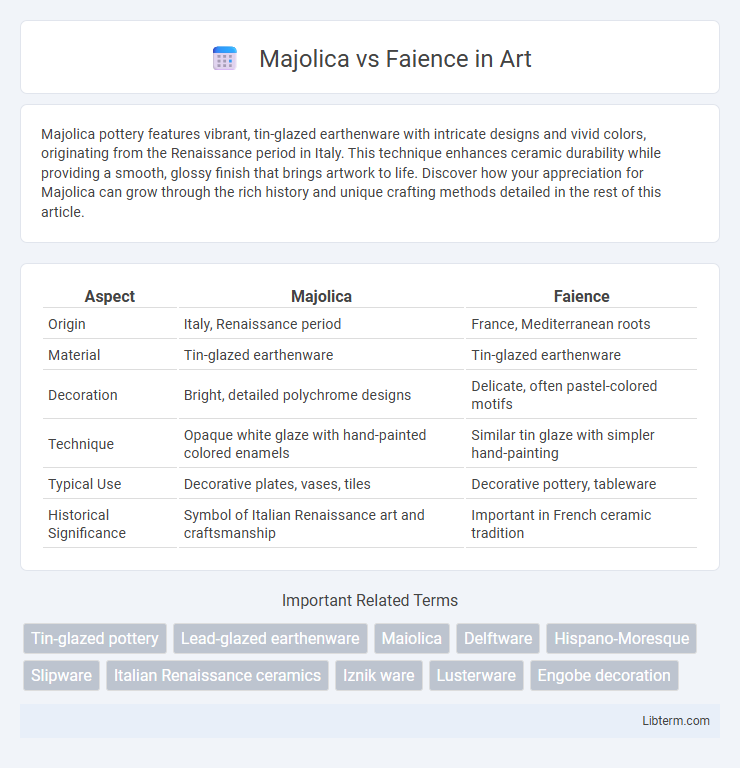Majolica pottery features vibrant, tin-glazed earthenware with intricate designs and vivid colors, originating from the Renaissance period in Italy. This technique enhances ceramic durability while providing a smooth, glossy finish that brings artwork to life. Discover how your appreciation for Majolica can grow through the rich history and unique crafting methods detailed in the rest of this article.
Table of Comparison
| Aspect | Majolica | Faience |
|---|---|---|
| Origin | Italy, Renaissance period | France, Mediterranean roots |
| Material | Tin-glazed earthenware | Tin-glazed earthenware |
| Decoration | Bright, detailed polychrome designs | Delicate, often pastel-colored motifs |
| Technique | Opaque white glaze with hand-painted colored enamels | Similar tin glaze with simpler hand-painting |
| Typical Use | Decorative plates, vases, tiles | Decorative pottery, tableware |
| Historical Significance | Symbol of Italian Renaissance art and craftsmanship | Important in French ceramic tradition |
Introduction to Majolica and Faience
Majolica refers to a type of tin-glazed pottery that originated in the Renaissance period, characterized by its vibrant colors and intricate designs on a white, opaque surface. Faience, often confused with Majolica, is a form of glazed ceramic ware that typically features a more muted color palette and originates from ancient Mediterranean cultures. Both Majolica and Faience are prized for their decorative appeal and historical significance in ceramic art.
Historical Origins and Development
Majolica, originating in the Italian Renaissance during the 15th century, evolved from Islamic pottery traditions brought to Europe through Spanish and North African trade routes. Faience, with roots tracing back to ancient Egypt and Mesopotamia, experienced a significant revival in 17th-century France, where it was popularized as tin-glazed earthenware characterized by intricate painted designs. Both ceramics utilize tin-glaze techniques but reflect distinct cultural influences and artistic developments tied to their respective historical periods and geographic regions.
Key Differences in Production Techniques
Majolica is characterized by its tin-glaze technique, where a white opaque glaze is applied to a ceramic body, followed by painting with metallic oxide enamels before firing at a lower temperature. Faience typically uses an earthenware body coated with a lead glaze without tin, resulting in a more translucent finish and often fired at higher temperatures compared to majolica. The distinction in glaze composition and firing processes directly affects the color vibrancy, texture, and durability between majolica and faience ceramics.
Materials and Glazing Processes
Majolica is crafted from a fine earthenware clay fired at lower temperatures, featuring a tin-glazed surface that creates an opaque, white base ideal for bright, colorful decorations. Faience also uses earthenware clay but is often less refined, with a lead-based glaze that produces a glossy, translucent finish enhancing intricate painted designs. The key distinction lies in Majolica's tin oxide glaze providing opacity, while Faience relies on lead glaze for clarity and depth in the decorative motifs.
Distinctive Artistic Styles
Majolica is characterized by vibrant, glazed earthenware featuring intricate, hand-painted designs often inspired by Renaissance motifs and natural elements such as flowers and animals. Faience, on the other hand, typically exhibits a more subdued color palette with delicate, finely detailed patterns influenced by European folk art and baroque styles. Both techniques use tin-glazing to create a smooth, opaque surface, but Majolica emphasizes bold, vivid colors while Faience leans toward softer, pastel hues with elaborate ornamental motifs.
Regional Variations and Influences
Majolica, originating primarily from Italy, showcases vibrant tin-glazed earthenware with distinct Renaissance motifs reflecting regional artistry in cities like Faenza and Deruta, while Faience, predominantly developed in France and Germany, features softer color palettes and floral designs influenced by local traditions and Asian exports. Italian Majolica emphasizes intricate narrative scenes and mythological themes, contrasting with the utilitarian and decorative purposes central to French and German Faience production. These regional variations highlight how geographical, cultural, and trade influences shaped the distinct aesthetics and functionality of tin-glazed ceramics across Europe.
Major Centers of Manufacture
Majolica production thrived in Italian cities such as Deruta, Faenza, and Urbino, renowned for their vibrant, tin-glazed earthenware featuring intricate Renaissance designs. Faience centers prominently emerged in French regions including Rouen, Nevers, and Marseille, known for their distinctive opaque tin glaze and detailed pictorial motifs. Both ceramic traditions reflect regional styles and techniques, with Italian Majolica emphasizing bright polychrome decoration and French Faience often showcasing softer color palettes and rustic charm.
Common Uses and Applications
Majolica and faience are both tin-glazed earthenware ceramics prized for their vibrant colors and intricate designs. Majolica is commonly used for decorative plates, tiles, and ornamental pottery due to its opaque glaze and vivid, detailed artwork. Faience, known for its slightly more porous texture and historical use in ancient Egypt and Europe, is often applied in functional items like jars, dishes, and architectural tiles.
Collecting and Identifying Majolica vs Faience
Collectors distinguish Majolica from Faience by examining glaze texture and color vibrancy; Majolica typically features a glossy, colorful lead glaze while Faience has a matte tin glaze with more subdued hues. Identifying marks such as maker's stamps, country of origin, and production dates aid collectors in authenticating and valuing each type. Provenance and stylistic elements provide crucial context in differentiating valuable Majolica pieces from Faience ceramics in collections.
Conclusion: Choosing Between Majolica and Faience
Choosing between majolica and faience depends on the desired artistic style and finish, as majolica features vibrant, opaque glazes with intricate relief designs, while faience offers a softer, tin-glazed surface with more subdued, matte colors. Collectors and decorators seeking bright, decorative ceramics often prefer majolica for its bold hues and texture, whereas faience appeals to those favoring traditional, historical aesthetics with a rustic charm. Both ceramic types provide unique cultural value and craftsmanship, making the choice subjective based on individual taste and usage.
Majolica Infographic

 libterm.com
libterm.com